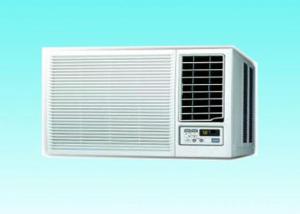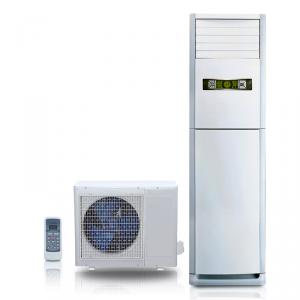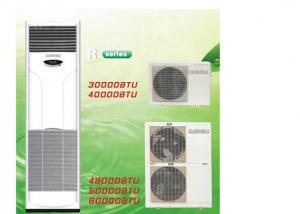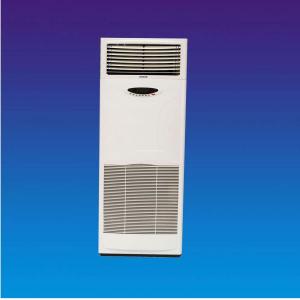Floor Standing Air Condition Units 48000Btu 220~230V 60Hz
- Loading Port:
- Beijiao or Nansha
- Payment Terms:
- L/C
- Min Order Qty:
- 20FCL set
- Supply Capability:
- 100,000 Sets per Month set/month
OKorder Service Pledge
OKorder Financial Service
You Might Also Like
Floor Standing Air Condition Units,48000Btu, 220~230V,60Hz
Features:
1) Intelligent control and display technology
2) Wide voltage design
3) Dual air guide plate technology
4) Memory functions
5) Sleeping mode automatic control
6) Audio prompt diagnosis on failures
7) Timed switch-on and switch-off
8) Cooling capacity: 48,000BTU
9) Heating capacity: 46,000BTU
10) Voltage: 220~230V/60Hz
FAQ
Q1:Why is it important to use home air conditioner filters?
A:Without them you can clog up vital parts of the heating or cooling components that can be difficult to clean out and can cause severe damage that will be much more expensive to repair than the inconvenience of replacing a filter once a month.
Q2:What is VRF Air Conditioning System?
A:VRF air-conditioning systems owe their growing popularity to their ability to meet a wide range of requirements.
- Q: A few years general air conditioning warranty?
- Air conditioning (Korean) machine, 1 year major parts for 3 years, main components including compressor, fan motor, thermostat Commercial air conditioning machine for two years, main components of 3 years, main components including compressor Air conditioning (suzhou) machine for 3 years, the main parts for 5 years, the main components including the compressor (5 years) Air conditioning (Korean) remote control (1 year product purchase the door repair for 15 days, 15 days to send) Air conditioning (suzhou) remote control (1 year product purchase the door repair for 15 days, 15 days to send)
- Q: Can I run my air conditioner 24/7?
- No, it is not recommended to run your air conditioner 24/7 as it can put excessive strain on the unit and result in higher energy consumption and potential damage. It is advisable to give the AC periodic rest periods to maintain its efficiency and longevity.
- Q: What kind of air conditioning the save electricity?
- A look at the indicators of energy efficiency Air conditioning province electricity, not saved look at can effect comparing index. Can effect comparing the higher, the province electricity. Worldwide, the current average the air-conditioning energy efficiency level is roughly 3.5; European above 3.2; Japan's long-term on behalf of the air-conditioning energy efficiency highest level, the highest for more than 6.0. Air conditioning can effect comparing with polarization state in China - the world's energy saving air conditioning for kelon company production in China, can effect comparing is 7.0, for the world record, save electricity and refrigeration and heating. But most of the air conditioning energy efficiency level is very low in our country, generally in 2.4 2.6. 2 see test results For part of the air conditioning manufacturer is the phenomenon of false advertising to mislead consumers, May 04, the hangzhou city disappear assist organized a domestic the largest air-conditioning consumption experience activity, 19 kinds of air-conditioning brand at home and abroad for the 30 hours of field experiments, as a result, 18 species of 1.5 air conditioning power consumption 8.54 degrees on average, at 5.67 degrees double efficient air conditioning "energy saving champions". Three core expertise For KongDiaoJie "SAS is healthy, with energy saving electricity" irresponsible phenomenon, experts advise consumers pay attention to enterprise's core expertise. Domestic only kelon focus energy saving technology, its multiple "air-conditioning energy saving the first brand in China". And some companies are today Shouting "health", "energy saving" at tomorrow.
- Q: Yituo 2 how to install air conditioning
- Are you a yituo two central air conditioning? Is said to be the type suction a top. If so, should install air conditioning inside the machine, and pipe in decorating. If decorate the first, then need to breakdown point. , of course, if the installation personnel technology in place, also be ok, like the size of the air conditioning after installed do not show. Play as big as air conditioning mouth first, and then wear cooling line, four anchors in roof, in the air conditioning on, after this setup's son also don't see what, the hope can help you, remember to take the answer.
- Q: Family expenses air conditioning, how a case to separate two blower to two rooms?
- It should be hung ark yituo 2 dc inverter, my family now have haier (KR - 25 g/U (ZF) + KR - 50 l/U (ZF) + KR - 68 w/(DBP), quite good, just don't know whether the production now, suggest to ask the malls and stores.
- Q: What are the advantages of a portable air conditioner?
- There are several advantages to owning a portable air conditioner. First and foremost, portability is a major advantage. Unlike traditional air conditioning units that are fixed in one place, portable air conditioners can easily be moved from room to room, providing cooling wherever it is needed. This is particularly useful for those who live in rental properties or individuals who frequently move residences. Another advantage is the ease of installation. Portable air conditioners typically come with a simple setup process that requires minimal technical knowledge. They usually come with a window installation kit, allowing users to quickly and easily vent the hot air outside. In contrast, traditional air conditioning units often require professional installation and can be a hassle to set up. Cost-effectiveness is another advantage of portable air conditioners. They are generally more affordable than central air conditioning systems and can be a great option for those on a budget. Additionally, because they are only used in specific rooms or areas, they allow for more efficient cooling and can help reduce energy consumption and utility bills. Furthermore, portable air conditioners are a versatile cooling solution. They often come with additional features such as dehumidification and fan modes, providing multi-functional benefits. These units can also be used as supplemental cooling in areas where central air conditioning is insufficient or non-existent. Lastly, portable air conditioners offer flexibility in terms of size and capacity. They come in various sizes to fit different room dimensions and cooling needs. This makes it possible to choose a unit that is perfect for a specific space, ensuring optimal cooling efficiency. In summary, the advantages of a portable air conditioner include portability, easy installation, cost-effectiveness, versatility, and flexibility. These units provide a convenient and efficient cooling solution for individuals who desire flexibility, affordability, and convenience in their air conditioning needs.
- Q: What is the difference between ordinary air conditioning and central air conditioning
- Central air conditioning, more than one machine room can use at the same time, also can open a single room, single open than the average points native demanding, there is a kind of a number of central air conditioning, there are several compressor, single open a room, will only start a press, inefficient and ordinary, province, good-looking, typically hidden in the ceiling, with the wind, such as shopping mall), and side wind (a hotel standard room), cost is high, ordinary fission air conditioning, a room one machine, can be single, don't open at the same time, save electricity, the ark of the sitting room, if you buy luxury apartments, suggested the central air conditioning, the sitting room with at least a small central air conditioning, save one square place, to pick up the air conditioning
- Q: What type of refrigerant home air conditioning?
- What air conditioning compressor is suited to the refrigerant, if the mark is to use with R22 refrigerant R22, if that want to use it with R410A refrigerant R410A refrigerant. Now has a good air conditioning refrigerant R410A refrigerant dupont, JuHua R410A refrigerant R410A refrigerant, daikin and so on
- Q: Air conditioning voltage is how many v?
- Ordinary household is 220 v, most of the industrial air conditioning is 380 v; Home air conditioning is divided into a lot of kinds, the kinds of common air conditioning and made cabinet air conditioning air conditioning, the window air conditioner and suspended ceiling type, have their own characteristics, but these products price also each are not identical, to choose according to their own requirements. Air conditioning is divided into single cooler air conditioning and the usage of air conditioning, work principle is the same, most commonly use freon refrigerant is in the air conditioning before. Freon feature is: the gas into a liquid, a lot of heat release. While the liquid into a gas, absorbs a lot of heat. (that is, the first endothermic heat gasification and liquefaction) air conditioning is designed according to this principle.
- Q: Air conditioning separate-bodied air-conditioners installed can higher than indoor machine
- No, as long as the indoor machine loading level. Out the water out
Send your message to us
Floor Standing Air Condition Units 48000Btu 220~230V 60Hz
- Loading Port:
- Beijiao or Nansha
- Payment Terms:
- L/C
- Min Order Qty:
- 20FCL set
- Supply Capability:
- 100,000 Sets per Month set/month
OKorder Service Pledge
OKorder Financial Service
Similar products
Hot products
Hot Searches
Related keywords
























